新目标英语八年级上册第6单元说课稿
- 格式:doc
- 大小:32.50 KB
- 文档页数:3
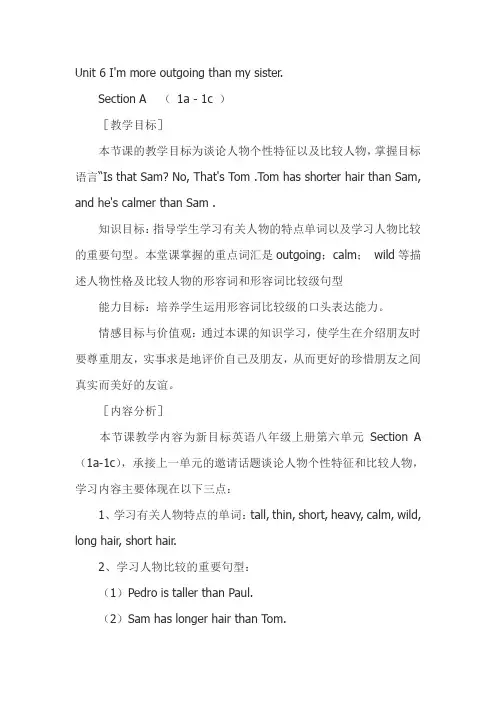
Unit 6 I'm more outgoing than my sister.Section A (1a - 1c )[教学目标]本节课的教学目标为谈论人物个性特征以及比较人物,掌握目标语言“Is that Sam? No, That's Tom .Tom has shorter hair than Sam, and he's calmer than Sam .知识目标:指导学生学习有关人物的特点单词以及学习人物比较的重要句型。
本堂课掌握的重点词汇是outgoing;calm;wild等描述人物性格及比较人物的形容词和形容词比较级句型能力目标:培养学生运用形容词比较级的口头表达能力。
情感目标与价值观:通过本课的知识学习,使学生在介绍朋友时要尊重朋友,实事求是地评价自己及朋友,从而更好的珍惜朋友之间真实而美好的友谊。
[内容分析]本节课教学内容为新目标英语八年级上册第六单元Section A (1a-1c),承接上一单元的邀请话题谈论人物个性特征和比较人物,学习内容主要体现在以下三点:1、学习有关人物特点的单词:tall, thin, short, heavy, calm, wild, long hair, short hair.2、学习人物比较的重要句型:(1)Pedro is taller than Paul.(2)Sam has longer hair than Tom.3、掌握语法点:形容词的比较级[学生分析]1、利用多媒体课件上英语课,学生视听感受明显,表现出极大兴趣,在欣赏和享受中学习,学习效果很明显。
2、描述人物特征在七年级已经学过,通过问答”What do they look like?“,复习旧知,学生能自然而然进入新课学习。
3、学生以前接触过形容词的比较级和最高级,如good-better-best, many-more-most, little-less-least,这为本节课学习奠定了很好的基础,理解起来更为容易。

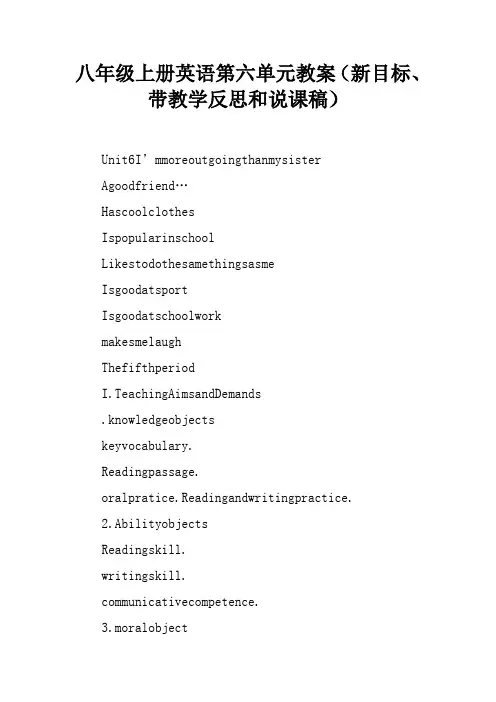
八年级上册英语第六单元教案(新目标、带教学反思和说课稿)Unit6I’mmoreoutgoingthanmysisterAgoodfriend…HascoolclothesIspopularinschoolLikestodothesamethingsasmeIsgoodatsportIsgoodatschoolworkmakesmelaughThefifthperiodI.TeachingAimsandDemands.knowledgeobjectskeyvocabulary.Readingpassage.oralpratice.Readingandwritingpractice.2.AbilityobjectsReadingskill.writingskill.communicativecompetence.3.moralobjectTakeanactivitypartinallkindsofsocialactivities.Getachancetotrainyourintergratingskills.II.TeachingImportanceandDifficultyoralpratice.writingandspeakingpraticeIII.TeachingmethodsListeningandwritingmethods.Readingandwritingmethods.communicativeapproach.Pairwork.IV.TeachingAidsAprojector.Piecesofpaperonwhichstudentswritethefivestatements.V.TeachingProcudruesStepIGreettheclassasusualandcheckthehomework.StepIIShowthenewwordsontheblackboard.ReadthenewwordstostudentsandaskthemtorepeatUnit6I’mmoreoutgoingthanmysisterAgoodfriend…HascoolclothesIspopularinschoolLikestodothesamethingsasmeIsgoodatsportIsgoodatschoolworkmakesmelaughThefifthperiodI.TeachingAimsandDemands.knowledgeobjectskeyvocabulary.Readingpassage.oralpratice.Readingandwritingpractice.2.AbilityobjectsReadingskill.writingskill.communicativecompetence.3.moralobject Takeanactivitypartinallkindsofsocialactivities. Getachancetotrainyourintergratingskills.II.TeachingImportanceandDifficultyoralpratice.writingandspeakingpraticeIII.TeachingmethodsListeningandwritingmethods.Readingandwritingmethods.communicativeapproach.Pairwork.IV.TeachingAidsAprojector.Piecesofpaperonwhichstudentswritethefivestatements.V.TeachingProcudruesStepIGreettheclassasusualandcheckthehomework.StepIIShowthenewwordsontheblackboard.Readthenewwordstostudentsandaskthemtorepeat.StepIII3aInthisactivityfirstreadthearticletostudents.Thenans weranyquestionsstudentsanyask.Forexample,S:what’sview?T:It’swhatyouthinkaboutsomething.It’showyoufeelaboutsomething.StepIV3bFirstletstudentslookatthechartinActivity2aonpage38. ThenaskstudentstowritetheirownsentencesaboutHolly’sfriendandsomesentencesaboutmaria’sfriend.StepV3cInthisactivityfirstaskstudentstosaysomeofthewordsan dphrasesfromthisunittheycanuse.Forexample, Tall,short,thin,heavyAthletic,intellectual,shyoutgoing,seriousStepVI2aInthisactivityfirstaskstudentstolookatthenamesandth efirstcolumnofthetalbe.Tellstudentstheywillhearanin terviewertalkingtoHollyandmaria.Theyaretalkingabout whattheylikeabouttheirbestfriends.StepVIIPairworkFindSomeoneforthejob!Focusstudentsonthejobad.Askstudentsiftheyknowthewor d—abacus.Iftheydon’tknow,explainittothem.Abacus—aframewithballsthatwasusedtodoarithmetic,longbeforecalculators.StepVIIIHomeworkandSummaryTodaywe’vereviewedthekeyvocabularyinthisunitbyreadingpratic e..Andwe’velearnttowriteaboutourbestfriends.Nowhomework,writ edownthewordsyouunderlinedinActivity3ainyourexercis ebook.StepIXBlackboardDesignUnit6I’mmoreoutgoingthanmysisterSentencesstudentswrite:Thenameofastudentwhoshouldge tthejobThesixthperiodI.TeachingAimsandDemands.knowledgeobjectsReviewingthekeyvocabularyinthisunit.writingpratice. justforfun.2.AbilityobjectsSelfcheckskill.writingskill.3.moralobjectStudyhardandmakegreatprogress.II.TeachingImportanceandDifficultywritingpratice.ReviewingthekeyvocabularyQuiet,funny ,outgoingkind,athleticIII.Teachingmethodsmunicativemethod.IV.TeachingAidsAprojector.Ataperecorder.V.TeachingProcudruesStepIGreettheclassasusualandcheckthehomework.StepIISelfcheck1Afterstudentsfinishwritingtheirsentences,writeanumb erofstudent’sanswersontheblackboard.myfriendlikessports.She’sveryathletic.Paulisneverquiet!Hecan’tstoptalking.mr.wangisakindman.Healwayshelpsothers.maryisafunnygirl.Shealwaysmakesmelaugh.janeisn’tveryoutgoing.Shelikestostayathomeandrest.StepIII2Firstaskdifferentstudentstoreadthequestions ontheleft.Studentsread.Areyoutallernow?Areyoumoreintellectual?Areyoumorepo pular?Areyouabetterstudent?Thenaskstudentstothinkofthemselvestwoyearsago.Howar etheydifferentnow?StepIVjustforFun!Asktwostudentstoreadthedialoguetotheclass.Twostuden tsread.A:IthinkIseethetwins.Isthatjuva?B:No,that’sjala.jalahascurlierhairthanjuva.A:Andjuvaistallerthanjava.writethewordscurly—curlierontheblackboard.Explainthewordscurlytostuden tsordrawasimplepicturewhatcurlierhairmeans.StepVworkbookReadthisarticleaboutAliandAhmet.Thenanswerthequesti onsStepVISummaryThisclasswe’vereviewedthekeyvocabularyoftheunit.Andwe’velearnthowtocompareourthemselvesbetweennowandtwoye arsago.Ihopeyoucanmakegreatprogress.StepVIIIHomeworkFinishofftheexercisesoftheworkbookStepIXBlackboardDesignUnit6I’mmoreoutgoingthanmysistercurlycurliercurlyhair。
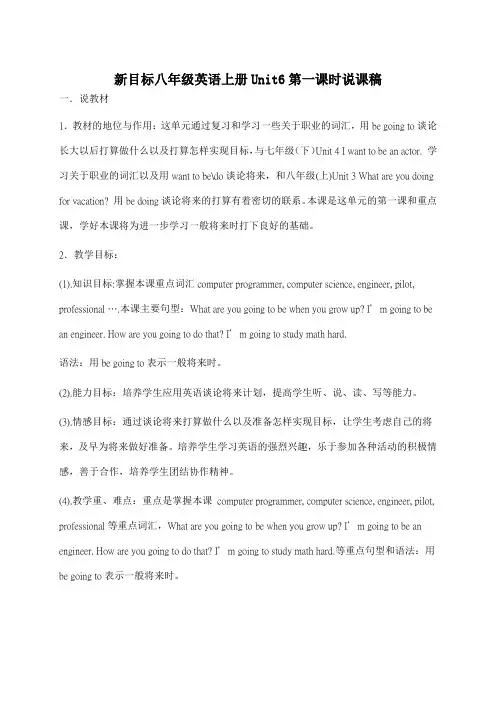
新目标八年级英语上册Unit6第一课时说课稿一.说教材1.教材的地位与作用:这单元通过复习和学习一些关于职业的词汇,用be going to谈论长大以后打算做什么以及打算怎样实现目标,与七年级(下)Unit 4 I want to be an actor. 学习关于职业的词汇以及用want to be\do谈论将来,和八年级(上)Unit 3 What are you doing for vacation? 用be doing谈论将来的打算有着密切的联系。
本课是这单元的第一课和重点课,学好本课将为进一步学习一般将来时打下良好的基础。
2.教学目标:(1).知识目标:掌握本课重点词汇computer programmer, computer science, engineer, pilot, professional ….本课主要句型:What are you going to be when you grow up? I’m going to be an engineer. How are you going to do that? I’m going to study math hard.语法:用be going to表示一般将来时。
(2).能力目标:培养学生应用英语谈论将来计划,提高学生听、说、读、写等能力。
(3).情感目标:通过谈论将来打算做什么以及准备怎样实现目标,让学生考虑自己的将来,及早为将来做好准备。
培养学生学习英语的强烈兴趣,乐于参加各种活动的积极情感,善于合作,培养学生团结协作精神。
(4).教学重、难点:重点是掌握本课computer programmer, computer science, engineer, pilot, professional等重点词汇,What a re you going to be when you grow up? I’m going to be an engineer. How are you going to do that? I’m going to study math hard.等重点句型和语法:用be going to表示一般将来时。
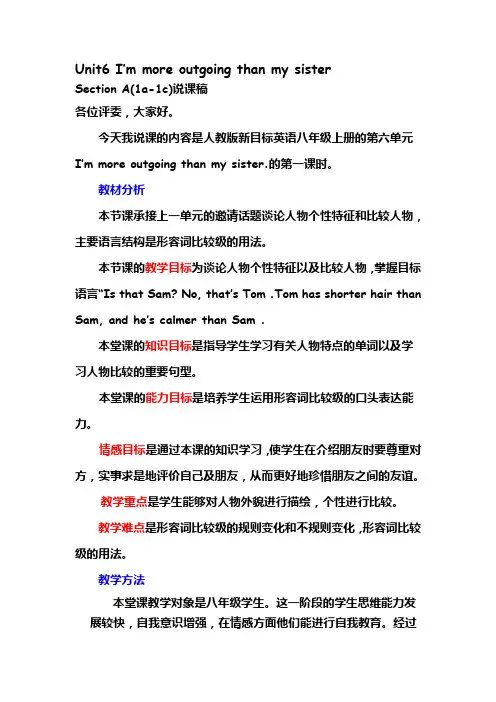
Unit6 I’m more outgoing than my sisterSection A(1a-1c)说课稿各位评委,大家好。
今天我说课的内容是人教版新目标英语八年级上册的第六单元I’m more outgoing than my sister.的第一课时。
教材分析本节课承接上一单元的邀请话题谈论人物个性特征和比较人物,主要语言结构是形容词比较级的用法。
本节课的教学目标为谈论人物个性特征以及比较人物,掌握目标语言“Is that Sam? No, t hat’s Tom .Tom has s horter hair than Sam, and he’s calmer than Sam .本堂课的知识目标是指导学生学习有关人物特点的单词以及学习人物比较的重要句型。
本堂课的能力目标是培养学生运用形容词比较级的口头表达能力。
情感目标是通过本课的知识学习,使学生在介绍朋友时要尊重对方,实事求是地评价自己及朋友,从而更好地珍惜朋友之间的友谊。
教学重点是学生能够对人物外貌进行描绘,个性进行比较。
教学难点是形容词比较级的规则变化和不规则变化,形容词比较级的用法。
教学方法本堂课教学对象是八年级学生。
这一阶段的学生思维能力发展较快,自我意识增强,在情感方面他们能进行自我教育。
经过一年的新课程理念的熏陶及实践,学生已有了初步的自主、合作、探究和实践的能力。
所以我以英语新课标为理论,根据现阶段我校学生英语教学的基本学情为依据,结合八年级学生的心理特点和认知发展规律,采用了1.听说法。
利用多媒体课件上英语课,使学生视听感受明显,激发学生的学习兴趣,并在轻松愉快的环境下学习英语。
2.课堂互动法。
通过师生交流,生生交流,实现师生互动。
鼓励学生大胆发言,营造平等交流气氛,让学生成为课堂学习的主体。
3 .直观教学法。
通过用图片展示教学生词,加深学生对单词以及形容词比较级的认识,使抽象的语言变得直观。
4.任务型教学法即按学生需要取材,由内容决定形式以及以任务为载体,以完成任务为动力。
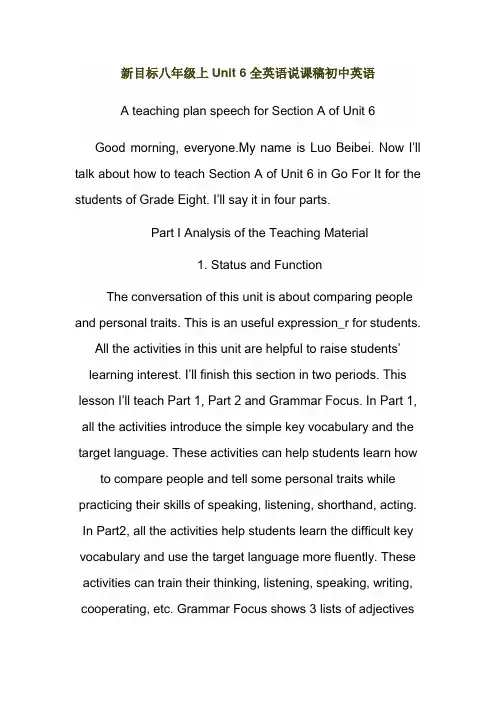
新目标八年级上Unit 6全英语说课稿初中英语A teaching plan speech for Section A of Unit 6Good morning, everyone.My name is Luo Beibei. Now I’ll talk about how to teach Section A of Unit 6 in Go For It for the students of Grade Eight. I’ll say it in four parts.Part I Analysis of the Teaching Material1. Status and FunctionThe conversation of this unit is about comparing people and personal traits. This is an useful expression_r for students.All the activities in this unit are helpful to raise students’ learning intere st. I’ll finish this section in two periods. This lesson I’ll teach Part 1, Part 2 and Grammar Focus. In Part 1, all the activities introduce the simple key vocabulary and the target language. These activities can help students learn how to compare people and tell some personal traits while practicing their skills of speaking, listening, shorthand, acting. In Part2, all the activities help students learn the difficult key vocabulary and use the target language more fluently. These activities can train their thinking, listening, speaking, writing, cooperating, etc. Grammar Focus shows 3 lists of adjectivesand comparative adjectives. The activities in this part can give students a chance to summarize the principles between adjective and comparative adjective by using their own wit. The grammar and the target language is the basis for students to learn the other contents of this unit. So it’s very important tolearn this lesson well.2. Analysis of the studentsStudents of their age are very active. They have strongthirst for knowledge and like to be challenged.3. Teaching Aims and DemandsThe teaching aims and demands are established according to Junior School English syllabus’ provision and theteaching material.(1) Knowledge ObjectIn this unit students learn to talk about personal traits andcompare people.Simple key vocabulary: calm, wild, thin, heavy, than.Difficult key vocabulary: smart, outgoing, athletic.Target language: Is this Sam? No, that’s Tom. He hasshorter hair than Sam.And h e’s calmer than SamGrammar: The comparative adjective(2) Ability ObjectTo train the students’ ability of listening, speaking, reading,andwriting.To train the students’ ability of shorthand, acting, thinking,conclusion, e(3)Moral ObjectEveryone has its own traits, whether you like or not, youshoudshow respect and find their beauties.4. Teaching ImportanceTo master the key vocabularyTo understand and use the target languageTo master the grammar of adjective and comparativeadjectiveOral practice5. Teaching DifficultiesHe has shorter hair than Sam. And he’s calmer than Sam.To enable the students to understand that they are the sentence patterns to talk about personal traits and comparepeople.To enable the students to use the target language.6. Teaching AidsMulti-media computer, Tape recorder, Software: PowerPoint or Author ware, clothes and masks. school thingsand so on. They wilbe needed in this lessonPart II The Teaching Methods1. Communicative teaching method2. Audio-visual teaching method3.”Task-based”teaching methodAs we all know: the main instructional aims of learning English in the Middle School is to cultivate students’ abilities of listening, speaking, reading, writing and their good sense ofthe E nglish language. So in this lesson I’ll mainly use “Communicative” teaching method,” Audio-visual”teaching method and “Task-based” teaching method.That is to say, I’ll let the students to get a better understanding of the target language master the vocabulary and grammar better. I’ll give the students some tasks and arrange several kinds of activities: watching pictures, writing, listening, making conversation, acting, group work and so on Teaching special features: To use these methods is helpful interest students and develop their thoughts.Part III Studying Ways1. Let the students master the key vocabulary better byguessing, acting, listening, using.2. Enable the students study English language byCommunicating, Describing, Listening.3. Let the students understand the grammar well bysummarizing the grammar rules by themselves.Part IV Teaching ProcedureStep 1 Chant and slogan before the class (1 minute) Ss: la la la ~~~Happy English! I enjoy, we enjoy!Step 2 Introduction (4 minutes)Show one picture which obviously shows one tallest students in our class. The picture has photoshopped to make the student seemed short in the picture. Then show another picture which shows one student who has the longest hair. And the picture is also photoshopped to make the student’s hairmuch shorter.Say: Is this Bella?No/YesWhy?(here students can use Chinese to express their reasons)While the student want to express their thought in English ,and they do not have learned the expression_rs, their desire for learning this part of knowledge will strongly beraised.Then, introduce the target language and give it an explanation in 2 aspects: grammar and the change of thepronunciation.After explanation, they can have rational knowledge to thetarget language.Step3 Using the target language (4 minutes)Practise the target language with long hair and tall. Students are allowed to speak slowly at the first time and alittle faster at the second time.This part, I give the student the chance to practice the target language. Improve their speaking.Step4 Simple key vocabulary and usage of target language(4 minutes)Guess the meaning of the simple key vocabulary (calm, wild, thin, heavy) while enjoying pictures. Describe the pictures by using the target language (that’s Tom. He has shorter hair than Sam. And he’s calmer than Sam) and the simple key vocabulary. I will choose some students to give their description of the picture, and the student can get 1 point as he dare to speak. Whether they are correct or not, I will encourage, praise them or give some pertinent suggestions.Pictures can attract students’ attention and guessing the meaning of the words help train the students’ thought. Using the target language by describing a picture shows another way of studying English. Giving students pertinent praise or advice will make the assessment worthwhile, cause different students get different assessments, not just good, excellent, wonderful.Step5 Listening and shorthand (4 minutes)Listen to the tape, and shorthand the key words. Then, write down the main information in the form of using the target language according to their own shorthand notes. When all have done with the work, I’ll give them the correct answers.And once again I will tell them the skills of shorthand.As shorthand is a useful skill in listening comprehension and modern society, students can learn and practise it fromnow on.Step6 Performance and communication (5 minutes)Divide the whole class into two parts. one part is for acting ,another part is for making a conversation. Deskmates make a group. Every performing group has a information card on which I have written down the key vocabulary and some hints about how to act. With a information card, the actors decide how to act well. While the actors are acting in front of the class, one of the groups from another part should make a conversation according to the performance. When the speaking group has finished their talk, the rest of the students which has divided into boys and girls are asked to repeat their dialogue. After all the students has showed and have gone back to their seats, there is one minute to grade all the groups with a chart on which there are 3 items (self-discipline, performing skills, speaking ) The chart is required to hand in, for I will conclude which group is the champion and will bring the result back the next class.Acting makes studentsunderstand the meaning of the key vocabulary better and attract the whole class. Making a conversation while some are acting, gives the student the circumstance to communicate with each other. Repeating the dialogues not only helps the rest of students’ discipline but also makes thempractice the target language as well. Grading their own performance is a new way and will make the students wannatry their best to perform well.Step7 Learn the difficult vocabulary by using the targetlanguage (4 minutes)Say: wanna watch flash?Learn difficult vocabulary (smart, outgoing, athletic) by watching short flash or DV. After each short video, student describes it by using the target language.Flash or DV will bring the climax of excitement. And considering about diversity I am not using pictures again.Step8 listening (8 minutes)Listen to the tape and finish the part 2a in the textbook. Before listening I will give a brief explanation of the question, and some advices for them to finish this task well.Step9 Consolidation of step4 and step7 (4 minutes)Show picture and ask the students to discover 8 different traits on two people in a picture within 2 minutes. You can discuss in groups and in English. And write the 8differences down in paper. At last, each group asks their representative to show their results in full sentence. Before the class I will repeat the rules that student and I all familiar with. Rules: 1) keep your voice at a moderate decibel so as to not disturb other classes, and learn to respect and listen attentively.2) discuss in English, Chinese is not allowed here.3) you canleave your seat to help discuss with your groupmates.Students practse their all the key vocabulary and target language in one task.As the students are challenged, they have the strong desire to win, that is to say, the students have great interest and will become quick-minded and exalted whilefinishing this task. This part practise their teamwork spirit,socializing ability speaking, writing.Step10 Moral education (3 minutes)Discuss the two people in the picture. Which one do youlike better? why?Then, gradually let them understand we should respecteveryone, because every one has its good merits and shortcoming. We should find people’s beauties not only look attheir shortcomings.Good teachers teach not only the students knowledge, but also how to be a man and behave.Step11 Grammar (3 minutes)While the 3 lists of adjective and comparative adjective are on the blackboard, students only have 1.5 minutes to find the rules .After 30 seconds I will give one hint, after another 30 seconds I’ll reveal the second hint, and one by one after each30 seconds. Without a hint, if a student can spill out the rules ,then he can get 5 points, with a hint, 3 points; with two hints, 2 points; with three hints, 1 point.It comes to grammar teaching. This part, students are trained to use their own wit to summarize some principles. This practised their thinking, meanwhile, the students will memorize this part of grammar better. This activity guides the students to study grammar by thinking hard and conclusion. After that they can have a rational knowledge to the grammar. It is designed to gain points, and students’ wit is challenged, so this activitywill arise the students’ interest.Step12Revison (1 minutes)Cover the blackboard for 30seconds, and let the students close their eyes and review what they have just learnt.Then uncover the blackboard, and scratch each key vocabulary and target language after the whole class has readit aloud and correctly.Make a better use of the difficulties and important information on the blackboard. Reviewing at the end of the class can help students’ memory,and let the students know that closing eyes and reviewing knowledge in their minds is a good way of revision. This part also practice the reading abilityand check the pronunciation.Step12 Homework (2 minutes)There are 3 choices for the students to choose.1.make a list of top 10 obvious traits or comparison aboutour classmates.2.make a list of top 10 obvious traits or comparisonbetween you and your best friend.3.make a list of top 10 obvious traits or comparisonbetween your parents.When it comes to the homework part, teachers shouldhave enough time to explaintheir assignment clearly to avoid misunderstanding of demands. At the meantime, teacher can give students some advices to finish their homework efficiently. And that’s why I spare two minutes. Homework which is related to the students’ life can surely trigger their interest to finish the homework earnestly. The homework can help the students to consolidate the target language and train their writing ability.Step13.Blackboard designUnit 6 I’m more outgoing than my sister-er -ier more ~ -Is that Sam?calm-calmer funny-funnier athletic-more athletic -No, that’s Tom, he has shorter hairtall-taller heavy-heavier outgoing-more outgoing than Sam. And he’s calmer than Samsmart-smarter happy-happier interesting-more interestingwild-wilder新目标英语八年级上册Unit 4((1a—2d)说课稿Hello, everyone. I’m Jiang Congling, I come from Zi Gui County .I have been an English teacher for 7 years in Yi Zhibi Middle School. Now I’ll say Section A(from 1ato 2d) of Unit 4 in Go For It. I’ll say the lesson from five parts.Part One : Analysis of the teaching materials1 Status and functionThis is an important lesson in this unit even in this book. This lesson is the first one of Unit 4 .So if the Ss can learn it well, it will be helpful to make the Ss learn the rest of this unit. In this lesson, the Ss learn the ways of transportation, such a topic is related to their daily life, so it can raise their learning interests and improve their spoken English.2 Analysis of the studentsStudents of Grade Eight have learned English for more than 4 years. They have a good foundation in words and sentences. They have mastered some skills of listening, speaking, reading, and writing. Most students have taken a great interest in English now, they enjoy learning English.3 Teaching aims and demandsa. Knowledge Objects(1)To make the Ss know how to use the sentences “How do you get to school? How does he get to school? How long does it take?”Let the Ss be able to answer the questions above.(2)To study the new words “take, subway, train, forty, fifty ……”etc. by learning the dialogue of this lesson.b. Abillity Objects(1) To develop the Ss’abilities oflistening ,speaking ,reading and writing.(2) To train the Ss’ability of working in pairs.(3) To develop the Ss’abilities of communication by learning the useful structures.c. Moral ObjectsTo enable the Ss to work with others and help each other.4 .Teaching key and difficult pointsa. Key points(1) To help the Ss to communicate with each other.(2) To enable the Ss to study in groups and co-operate skillfully.b. Difficult pointsDistinguish the use of “take”.5 Teaching AidsA tape recorder, cards, the multi-media computer.Part Two: The teaching methods1. Communicative teaching method.2. “Audio-visual”teaching method.3.Task-based teaching method.To use these methods is helpful to develop the Ss’thought. As we all know: the main instructional aims of learning English in the Middle School is to cultivate students’abilities of listening, speaking, reading, writing and their good sense of the English language. So in this lesson I’ll mainly use “Communicative”teaching method, “Audio-visual”teaching method and “Task-based”teaching method. That is to say, I’ll let the Ss to get a better understanding of the key structure of the dialogue. I’ll give the Ss some tasks and arrange fivekinds of activities: listening, guessing games, watching CAI, acting out dialogues and making a survey.Part Three: Studying methodsI request the students to study English independenly cooperatively and investigatively. Each unit in Go for it contains pair work, group work and games. The students who sit at the same table and groups can make a discussion and learn each other. It makes each student be relaxed. They needn’t worry about making mistakes. It can arouse students to think and to say what they want to say. Study becomes more relaxed and pleased in this kind of environment.Part Four: Teaching proceduresStep 1 Warm-upFree talk between the Ss. What are you doing this Sunday? What is he doing tomorrow ? In this course, I’ll ask them to make a dialogue group by group, find out which group makes the best dialogues.Purpose of my designing: I think it’s important to form a better English surrounding for Ss, and it’s necessary to provide situation to review learnedknowledge.Step 2 Presentation1.Let the Ss look at the pictures on the screen and answer the following questions: What is the girl doing? Does she often ride a bike to get to school? How do you get to school? Then I write down the sentence on the blackboard. I help the students to answer “take the subway, take the train”2.Play a guessing game. How does he\she get to work? I’ll ask them about the famous stars, such as Yao Ming, Liu Yifei, Zhang Weijian, Zhou Jielun, Liu Xiang, etc. They are popular among the Ss in China. The Ss must be interested in them.3.Ask the Ss to complete 1a, then check the answers with them.Purpose of my designing: To present transportations by CAI is much easier for the Ss to learn and grasp the meanings. CAI can provide a real situation with its sound and picture and it makes the relationships between the Ss better.Step 3 listeningBefore I play 1b for the Ss, I ask the Ss “How do you get to school?”, I want them to remember the ways of transportation. So I ask the Ss to listen to the sound of the transportations and guess what kind of transportation it is. And then I ask one student to read the names of 1b, and I play 1b, let the Ss complete 1b, then check the answer. And then Let the Ss listen and imitate the dialogue. Pay attention to their pronunciation and intonation.Step 4Pair work and group workAsk two Ss to read the conversation, then let the Ss practice in pairs. After that , ask them to practice in groups like this: A: How do you get to school? B: I take a subway. C: How does B get to school? D: He takes a subway.Encourage them to use different words and find out the best group. In this step the Ss are required to practise the Sample in pairs by reading the dialogue aloud. This step is employed to make the Ss grasp the Sample .At last I’ll ask the Ss to think hard and act it out with a partner according to Sample. Then find out which group will actit out well. I’ll give them some cards with numbers as a prize.Purpose of my designing: This step is employed to make the Ss get the general idea of the dialogue as a whole one. At the same time let the Ss have a chance to practise their listening and spoken ability. “Task-based”teaching method is used here to develop the Ss’ability of communication and also their ability of co-operation will be well trained. I think proper competition can arouse the Ss’interest in English learning. If the Ss can finish this task well, they will benefit a lot in their spoken English.Step 5presentationTell the Ss that different ways of transportation takes different time . If I take a bus , it takes me 20 minutes; If I ride a bike , it takes 40 minutes; If I walk, it takes 50 minutes. Then let the Ss listen and repeat 2a.Make sure the Ss read the words correctly.Then let the Ss complete 2b, and read the numbers aloud. Check one by one. And then ask the Ss: Can you read the following time? Let’s read together.Step 6Listening practice -2cIn this step, first I ask the Ss to name the five ways of transportation, next just listen to the tape, listen again, check the kinds of transportation that you hear. Listen for the third time, match the time with the kinds of transportation. While the Ss listening, I go around the classroom and help the Ss who have trouble in listening.Step 7Pair work -2dLet two Ss read in pairs, make sure they have no problems in understanding the conversation. Maybe they can’t distinguish the use of “take”. Ask them to discuss in groups, then find out the difference between them. Write down “How long does it take ?”on the blackboard.After that, let the Ss make a conversation about how they get to school and how long it takes.In this way , the Ss can learn how to communicate with each other.Step 8 Make a survey and give a reportInterview your classmates or our teachers here by using the following questions: How do you get to school? How long does it take? And then ask some Ss to give reportsto us.Purpose of my designing: I think survey is so important that the Ss should speak English as much as they can in class or after class. It is necessary for the Ss to investigate the others to consolidate the knowledge they learned.Step 9 Sum and tell the lucky numbersPart Five: Blackboard designUnit 4 How do you get to school?take the train forty How do you get to school?ride the bike fifty I ride my bike.take the subway sixty How does he get to school?take the bus seventy He walks to school.eighty How long does it take?ninety It takes about forty minutes.教学反思:In this lesson, I mainly adopt the Task-Based Learning Method. Try to have students learn by guessing, by having a competition, by investigation. I design many various activities that close to students’life so as to help students solve the difficulties and importance. I also arrange individual work, pair work, group work for students to practice English. I think if I want the student to improve their oral English, I must give them more chances to practice. That is “Learning by doing, Learning by using ”. In this case, I designed tasks according to the《New English Curriculum Criterion》, I will lead my students to study and cooperate with each other. Because the《New English Curriculum Criterion》points out that the general aim of English teaching in this stage of Junior Education is to cultivate students’comprehensive ability of using English. So I think my teaching methods are in line with the requirement of《New English Curriculum Criterion》.Good afternoon, everyone. I’m Zhou Yan. I’m an English teacher from Experimental School of Suqian. Now I’ll say Sample A of Lesson Six in Book One. I’ll prepare to say thelesson from four parts.Part One Analysis of the Teaching Material(一) STATUS AND FUNCTION1.This is an important lesson in Book One. From this lesson, it starts asking the Ss to grasp contents of each Sample. To attain “four skills” request of listening, speaking, reading and writing. To start listing “Word Bank” and tell the Ss to remember the new words. To start asking the Ss to write the English sentences well. Therefore this lesson is in the important position of the teaching material.2.This lesson is the first one of Unit 2.So if the Ss can learn it well, it will be helpful to make the Ss learn the rest of this unit.3.Such a topic is related to daily life, so it is helpful to raise learning interests of students and it will be also helpful to improve their spoken English.(二)ANALYSIS OF THE STUDENTSThe Ss has learned English for about one month so far. They can understand some words and some simple sentences. The Ss have taken a great interest in English now.(三)TEACHING AIMS AND DEMANDSThe teaching aim/'s basis is established according to JuniorSchool English syllabus/' provision.1.Knowledge objects(1) To make the Ss know how to use the affirmative sentence “This is. . . .” and the negative sentence “This is not….”Everyday expressions for “Apologies”“I/'m sorry”“That/'s all right”. (2) To study the new words “six, hey, sorry, it’s, that’s”, etc. by learning the dialogue of this lesson.(3) To finish some exercises.2.Ability objects(1) To develop the Ss’ abilities of listening, speaking, reading and writing.(2) To train the Ss’ ability of working in pairs.(3) To develop the Ss’ abilities of communication by learning the useful structures.3.Moral objects(1) To enable the Ss to be polite and love life.(2) To enable the Ss to look after their things well.(四)TEACHING KEY AND DIFFICULT POINTSThe teaching key and difficult points’ basis is established according to Sample A of Lesson Six in the teaching material/'s position and function.1.Key points:(1).To help the Ss to communicate with each other.(2).To enable the Ss to study in groups and co-operate skillfully.(3).To develop the Ss’ interest in English.2.Difficult points:(1) How to make dialogues and act them out.(2) How to write the right whole sentences.(五) TEACHING AIDSMulti-media computer, Tape recorder, Software: Powerpoint or Authorware, school things and so on. They will be needed in this lesson.Part Two The Teaching Methods1. Communicative teaching method2. Audio-visual teaching method3. Task-based” teaching methodAs we all know: the main instructional aims of learning English in the Middle School is to cultivate students’ abilities of listening, speaking, reading, writing and their good sense of the English l anguage. So in this lesson I’ll mainly use “Communicative” teaching method, “Audio-visual” teaching method and “Task-based” teaching method. That is to say, I’ll let the Ss to get a better understanding of the key structure of the dialogue.I’ll give the S s some tasks and arrange five kinds of activities: talking, guessing games, watching CAI, acting out Sample A and having a competition.Teaching special featuresTo use these methods are helpful to develop the Ss’ thought.Part Three STUDYING WAYS1.Teach the Ss how to be successful language learners.2.Let the Ss pass /"Observation—Imitation—Practice /" to study language.3.Teach the Ss how to master dialogues and how to communicate with others.Teaching special features:Let the Ss communicate with each other and adopt competition methods to develop the Ss’ keen interest in English.。

人教版新目标英语八年级上册《unit 6》英语说课稿人教版新目标英语八年级上册《unit 6》英语说课稿各位老师:大家好,今天我要说课的内容是初二英语上册第6单元SectionA 的前部分,Title(题目)是I`m more outing than my sister.其主要的内容是:“Talk about personal traits and how to compare people.”一话题。
由于本单元具有两部分:SectionA和SectionB,从教材的整合来说本部分即有形容词用法的延续,又为后面形容词最高级的学习打下基础,具有承上启下的作用;再则,从本单元来说它既是本单元的基本语言内容,又为本单元知识扩展和综合语言运用奠定坚实的基础。
因此,上好SectionA的前部分,既可让知识学习具有一定的延续性,又可为下面的教学做好铺垫,对完成本单元和今后的英语教学具有重要的意义。
对于SectionA前部分的教学,我准备把对词汇的掌握和听力的理解作为重点,把结对活动的核心对话(即学生说的能力培养)作为难点。
这是因为我校地处农村,学生在英语学习方面没有一个好的语言氛围,有些学生不能拥有自己的一套磁带,更不用说拥有其他的听力辅助材料,因此解决这一重点,能让学生进一步感受英语语言的美,激发他们的学习兴趣,这为突破难点作好铺垫;而难点的确立是由于本套教材的特点是采用任务型语言教学模式,融汇话题、交际功能和语言结构,形成了一套循序渐进的生活化的学习程序并结合我校“新课程与学习方式的转变”课题实践,从而突出学生参与探究活动的主体作用。
基于以上的分析,本节的教学要达到以下几个目标:在“知识目标”中,通过教学让学生掌握本课的词汇运用;“能力目标”方面:指导学生在自主探究和任务型教学模式中,让学生学会用英语与他人谈论人的个性特征和形容词的比较的话题,以及进一步提高听力能力和英语语言表达能力;“情感、态度、价值观”方面:通过师生在教学的双边活动中主动性和创造性的发挥,激发学生的学习兴趣,体验英语语言的美,体验知识间的相互应用、相互依存、联系,让学生充满自信,体验成就感和合作精神。
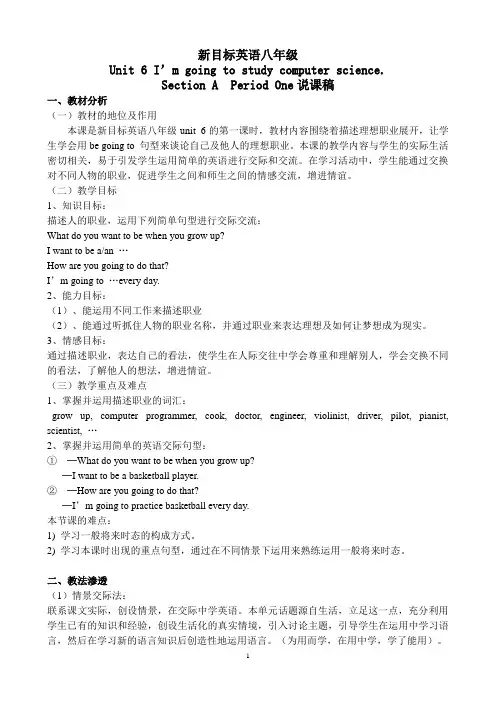
新目标英语八年级Unit 6 I’m going to study computer science.Section A Period One说课稿一、教材分析(一)教材的地位及作用本课是新目标英语八年级unit 6的第一课时,教材内容围绕着描述理想职业展开,让学生学会用be going to 句型来谈论自己及他人的理想职业。
本课的教学内容与学生的实际生活密切相关,易于引发学生运用简单的英语进行交际和交流。
在学习活动中,学生能通过交换对不同人物的职业,促进学生之间和师生之间的情感交流,增进情谊。
(二)教学目标1、知识目标:描述人的职业,运用下列简单句型进行交际交流:What do you want to be when you grow up?I want to be a/an …How are you going to do that?I’m going to …every day.2、能力目标:(1)、能运用不同工作来描述职业(2)、能通过听抓住人物的职业名称,并通过职业来表达理想及如何让梦想成为现实。
3、情感目标:通过描述职业,表达自己的看法,使学生在人际交往中学会尊重和理解别人,学会交换不同的看法,了解他人的想法,增进情谊。
(三)教学重点及难点1、掌握并运用描述职业的词汇:grow up, computer programmer, cook, doctor, engineer, violinist, driver, pilot, pianist, scientist, …2、掌握并运用简单的英语交际句型:①─What do you want to be when you grow up?─I want to be a basketball player.②─How are you going to do that?─I’m going to practice basketball every day.本节课的难点:1) 学习一般将来时态的构成方式。
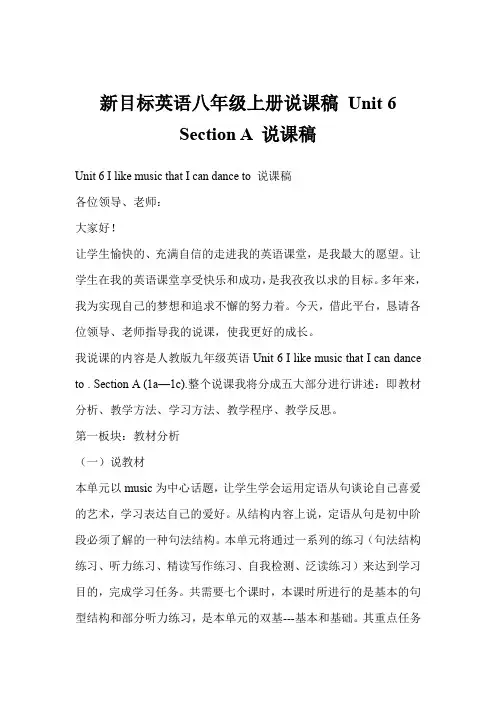
新目标英语八年级上册说课稿Unit 6Section A 说课稿Unit 6 I like music that I can dance to 说课稿各位领导、老师:大家好!让学生愉快的、充满自信的走进我的英语课堂,是我最大的愿望。
让学生在我的英语课堂享受快乐和成功,是我孜孜以求的目标。
多年来,我为实现自己的梦想和追求不懈的努力着。
今天,借此平台,恳请各位领导、老师指导我的说课,使我更好的成长。
我说课的内容是人教版九年级英语Unit 6 I like music that I can dance to . Section A (1a—1c).整个说课我将分成五大部分进行讲述:即教材分析、教学方法、学习方法、教学程序、教学反思。
第一板块:教材分析(一)说教材本单元以music为中心话题,让学生学会运用定语从句谈论自己喜爱的艺术,学习表达自己的爱好。
从结构内容上说,定语从句是初中阶段必须了解的一种句法结构。
本单元将通过一系列的练习(句法结构练习、听力练习、精读写作练习、自我检测、泛读练习)来达到学习目的,完成学习任务。
共需要七个课时,本课时所进行的是基本的句型结构和部分听力练习,是本单元的双基---基本和基础。
其重点任务是导入新的语言即New Function Presenting .因此这一节课我分成两个部分:第一部分引入定语从句的学习:第二部分围绕I like music that I can dance to .这一话题展开思维(1a)、听力(1b)、口语(1c)训练进行授课,最终完成本课时的教学任务。
(二)教学目标根据《英语课程标准》的教学理念,教材特点以及学生的实际情况,将本课时的教学目标确定如下:1 Knowledge objects(1) Key vocabulary prefer ,lyric(2) Target language What kind of music do you like ? I like music that I can dance to . . What about you ? I prefer music that has great lyrics.2 Ability objects(1) Train students to express preferences(2) Train students’listening skills3 Moral objectsLet’s enjoy music .Let’s enjoy ourselves. Let’s enjoy life.教学重点(1) Key V ocabulary prefer , lyric (2) Target language (四) 教学难点(1) Attributive clauses with that/who . (2) The listening practice .第二板块:教学方法由于英语是一门综合性与实践性相结合的科目,根据本文内容,综合到新教育理论,本课主要采用任务型教学法,情景教学法以及多媒体辅助教学,充分发挥教师的主导作用和学生的主体地位。
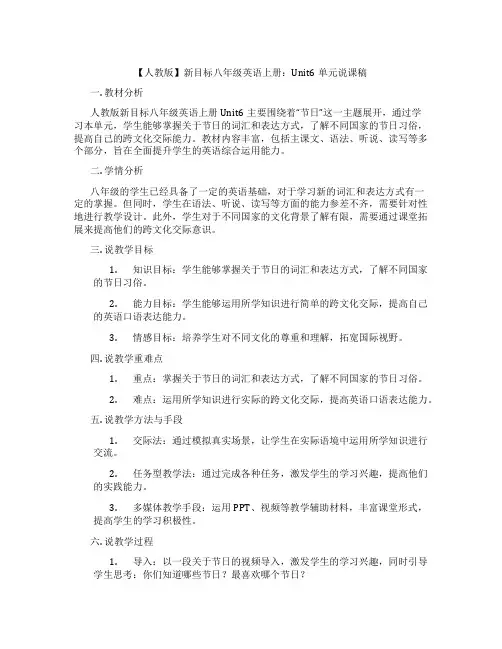
【人教版】新目标八年级英语上册:Unit6单元说课稿一. 教材分析人教版新目标八年级英语上册Unit6主要围绕着“节日”这一主题展开,通过学习本单元,学生能够掌握关于节日的词汇和表达方式,了解不同国家的节日习俗,提高自己的跨文化交际能力。
教材内容丰富,包括主课文、语法、听说、读写等多个部分,旨在全面提升学生的英语综合运用能力。
二. 学情分析八年级的学生已经具备了一定的英语基础,对于学习新的词汇和表达方式有一定的掌握。
但同时,学生在语法、听说、读写等方面的能力参差不齐,需要针对性地进行教学设计。
此外,学生对于不同国家的文化背景了解有限,需要通过课堂拓展来提高他们的跨文化交际意识。
三. 说教学目标1.知识目标:学生能够掌握关于节日的词汇和表达方式,了解不同国家的节日习俗。
2.能力目标:学生能够运用所学知识进行简单的跨文化交际,提高自己的英语口语表达能力。
3.情感目标:培养学生对不同文化的尊重和理解,拓宽国际视野。
四. 说教学重难点1.重点:掌握关于节日的词汇和表达方式,了解不同国家的节日习俗。
2.难点:运用所学知识进行实际的跨文化交际,提高英语口语表达能力。
五. 说教学方法与手段1.交际法:通过模拟真实场景,让学生在实际语境中运用所学知识进行交流。
2.任务型教学法:通过完成各种任务,激发学生的学习兴趣,提高他们的实践能力。
3.多媒体教学手段:运用PPT、视频等教学辅助材料,丰富课堂形式,提高学生的学习积极性。
六. 说教学过程1.导入:以一段关于节日的视频导入,激发学生的学习兴趣,同时引导学生思考:你们知道哪些节日?最喜欢哪个节日?2.新课呈现:通过PPT展示本节课的主要内容,包括节日词汇和表达方式,不同国家的节日习俗等。
3.课堂实践:模拟真实场景,让学生分组进行角色扮演,运用所学知识进行跨文化交际。
4.语法讲解:针对本节课的语法点,进行详细的讲解和示例,让学生在理解的基础上进行运用。
5.听力训练:播放一段关于节日的听力材料,学生听后进行问答,检查学生对听力材料的理解程度。
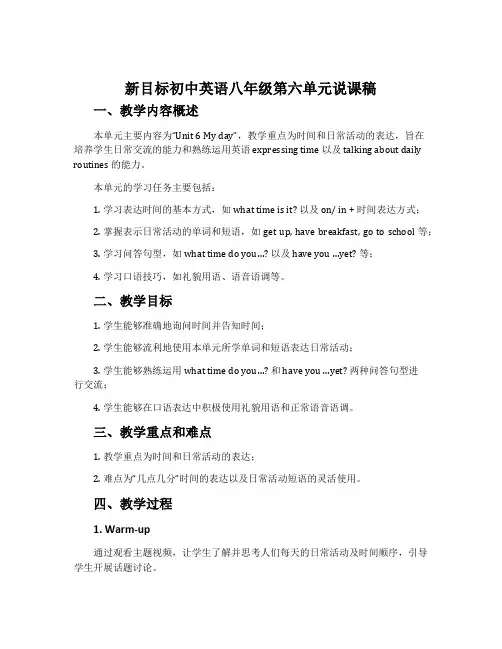
新目标初中英语八年级第六单元说课稿一、教学内容概述本单元主要内容为“Unit 6 My day”,教学重点为时间和日常活动的表达,旨在培养学生日常交流的能力和熟练运用英语 expressing time 以及 talking about daily routines 的能力。
本单元的学习任务主要包括:1.学习表达时间的基本方式,如 what time is it? 以及 on/ in + 时间表达方式;2.掌握表示日常活动的单词和短语,如 get up, have breakfast, go to school 等;3.学习问答句型,如what time do you…? 以及have you …yet? 等;4.学习口语技巧,如礼貌用语、语音语调等。
二、教学目标1.学生能够准确地询问时间并告知时间;2.学生能够流利地使用本单元所学单词和短语表达日常活动;3.学生能够熟练运用what time do you…? 和have you …yet? 两种问答句型进行交流;4.学生能够在口语表达中积极使用礼貌用语和正常语音语调。
三、教学重点和难点1.教学重点为时间和日常活动的表达;2.难点为“几点几分”时间的表达以及日常活动短语的灵活使用。
四、教学过程1. Warm-up通过观看主题视频,让学生了解并思考人们每天的日常活动及时间顺序,引导学生开展话题讨论。
2. Presentation通过图片、音频、视频等多种媒体语言让学生掌握时间和日常活动的表达方式,培养学生口语表达能力。
3. Practice1.针对时间问答部分,设计所需问题进行练习;2.针对日常活动,设计所需情景进行问答练习,如“请对方告知自己最近的日常生活”等。
4. Consolidation通过作业练习巩固本单元所学知识。
5. Extension1.针对本单元所学内容,设计生活实践任务;2.设计游戏、竞赛、角色扮演等多种形式的课堂活动,激发学生学习兴趣。
新目标英语初中八年级第六单元说课教案教学目标本次课程的教学目标主要包括以下三个方面:1.学生能够掌握本单元的词汇和语法知识。
2.学生能够运用所学知识,进行口语交际和书面表达。
3.学生能够深入理解英语语言和文化,并能够培养跨文化交流的能力。
教学内容本单元的主要教学内容包括以下三方面:1.词汇:语言学习常用词汇,并掌握其用法和拼写。
2.语法:掌握本单元涉及的语法结构,如虚拟语气和被动语态。
3.句型:学习并掌握一些常见的口语和书面表达用法,如倒装句和宾语从句等。
教学方法本次教学将采取以下三种方法:1.演示法:通过教师进行实际演示和示范,帮助学生理解和掌握所学知识。
2.对话法:通过教师和学生之间的互动对话,促进学生运用所学知识进行口语交际。
3.学以致用法:通过实际情境中的练习和应用,帮助学生将所学知识转化为实际语言技能。
教学步骤1.教师介绍本单元教学内容,包括教学目标、教学内容和教学方法。
2.教师通过示范和讲解,帮助学生了解和掌握本单元的词汇和语法知识。
3.教师设计一些实际情境,通过对话和练习帮助学生进行口语交际和书面表达。
4.教师和学生之间进行互动,促进学生的学习和理解,帮助学生深入理解英语语言和文化。
5.教师针对学生实际情况和学情,进行个性化教学和辅导。
教学评价为了评价和监控学生的学习效果,本次课程将采用以下几种评价方式:1.课堂测验:通过课堂测验检测学生是否掌握本单元的基础知识。
2.作业评价:通过写作和口语练习等方式,评价学生的语言技能和逻辑思维能力。
3.互动评价:通过学生之间的互动和教师的观察,评价学生的口语表达和交际能力。
教学建议针对本次课程的设计和教学,以下是一些教学建议:1.设计更多的实际情境,增加课程的趣味性和互动性。
2.增加学生的实际练习时间,减少教师的讲解时间。
3.增加个性化的教学和辅导,满足学生的不同学情和需求。
4.给予学生及时的反馈和建议,帮助学生不断改进和提高。
5.加强和家长的沟通和联系,促进学生英语教育的家校合作。
新目标英语八年级上册说课稿Unit 6 I am more outgoing than my sister一、教材分析(一) 教材的地位及作用《新目标英语》教材的语言教育理念是:知识用于行动强调“语言应用”,培养“创新、实践能力”,发展“学习策略”。
它采用任务型语言教学(Task-based Language Teaching)模式。
教材中每单元都设计一个或几个与该单元话题有关的任务,让学生在完成任务的过程中,使用英语获取信息,用英语进行交流,培养运用英语解决实际问题的能力。
(二)基于以上的分析,本节的教学要达到以下几个目标:1.学习目标:(1)能理解并复述3a.(2)能通过小组合作完成写作练习。
2.情感目标:(1)通过形象、生动的教学使学生掌握如何去比较两个人,并从中学会欣赏别人中,享受与不同的人交往的乐趣。
(2)培养学生学习英语的强烈兴趣,乐于参加各种活动的积极情感。
3、重点与难点:重点:学会用形容词的比较级来对两个人的外貌及个性进行比较。
难点:文章中较难句子的理解及应用。
二、说教法:为了更好地突出重点,突破难点,我主要采用了:1.任务型教学法:新课标倡导的“玩中学,学中玩”的理念也很受学生欢迎。
例如,阅读文章时我设计了一张表格,让学生阅读后完成表格并复述。
培养学生逻辑分类与表述能力。
2.情景交际法:情景交际教学法,是尽量给学生以足够的听、说、读的机会,联系课文实际,创设情景,引入讨论主题,在交际中学英语。
初二上期的学生经过一年多的学习,有了一定的英语基础知识和听说能力,正逐渐向读、写过渡,而本节课谈论的正是学生喜欢并且关注的话题“朋友”,经过对文章中他人选择朋友标准的学习,再调动学生自己的主观能动性,经过思考再写出自己对朋友的认识。
不仅进一步对语言学习进行了巩固,并在学习中融入了生活实践。
三、说学法:1.引导学生善于抓住使用英语交际的机会,充分感知,积极体验,大胆实践。
例如,在复习环节,学生可以利用很多机会:2分钟限时竞赛,我来比一比活动。
初二英语上册unit6说课稿Unit 6 说课稿尊敬的各位老师,大家好。
今天,我将就初二英语上册的第六单元进行说课。
本单元的主题是“购物”,旨在通过与购物相关的语言点和活动,提高学生的英语交际能力。
一、教学目标1. 知识目标:学生能够掌握购物相关的词汇,如“size”, “color”, “price”, “discount”等,并能够使用这些词汇进行基本的购物对话。
2. 能力目标:通过模拟购物场景,学生能够运用所学词汇和句型进行实际的购物交流。
3. 情感目标:培养学生的购物礼仪和消费观念,理解并实践公平交易和诚信购物。
二、教学重点1. 购物相关的词汇和表达方式。
2. 如何询问物品的价格、颜色、尺寸等信息。
3. 表达购买意愿和拒绝购买的礼貌用语。
三、教学难点1. 学生能够灵活运用购物相关的句型进行交流。
2. 理解并运用购物时的礼貌用语和交际技巧。
四、教学方法1. 情景教学法:通过模拟购物场景,让学生在实际情境中学习和使用语言。
2. 合作学习法:鼓励学生分组合作,通过角色扮演等形式,共同完成购物任务。
3. 任务型教学法:设置具体的购物任务,让学生在完成任务的过程中学习和运用语言。
五、教学过程1. 导入(Lead-in):- 通过展示一些购物图片或视频,激发学生对购物话题的兴趣。
- 简单讨论学生平时的购物经历,引导学生思考购物时可能用到的英语表达。
2. 呈现(Presentation):- 教授购物相关的词汇和句型,如“Can I help you?”, “What size/color do you want?”, “How much is it?”等。
- 通过图片或实物,帮助学生直观理解词汇。
3. 练习(Practice):- 学生两人一组,进行角色扮演练习,模拟购物对话。
- 教师提供一些购物场景,让学生用所学句型进行对话。
4. 应用(Application):- 组织一个模拟购物活动,学生需要使用英语完成购物任务。
新目标英语初中八年级第六单元说课教案教学目标:1. 听说:能够听懂并运用本单元的生词和句型,描述自己和别人的新目标。
2. 读写:掌握本单元的重点词汇和句型,能够读懂相关文章并写出自己的计划。
3. 文化意识:通过学习本单元的内容,培养学生的目标意识和自我管理能力。
教学重点:1. 掌握本单元的重点词汇和句型,能够用英语描述自己和别人的新目标。
2. 学会阅读文章,获取信息。
教学难点:1. 学会用英语描述自己和别人的新目标。
2. 提高学生的阅读能力,培养他们获取信息的能力。
教学准备:教材《新目标英语》初中八年级上册多媒体设备课件PPT教学过程:Step 1:导入(5分钟)通过图片和问题导入新课,引发学生对新目标的思考。
如:What are some of your goals for this year? What do you want to achieve?Step 2:预习任务(5分钟)让学生预习课文,并回答以下问题:1. What is Tony's goal for this year?2. What is Emma's goal for this year?Step 3:展示任务(10分钟)通过多媒体设备展示课文,并让学生跟读。
然后回答以下问题:1. What does Tony want to improve this year?2. What does Emma want to learn to do this year?3. What does Emma plan to do to achieve her goal?Step 4:重点句型(10分钟)通过多媒体设备展示课文中的重点句型,并让学生跟读并模仿。
然后进行操练练习。
如:1. Tony wants to improve his English this year.2. Emma wants to learn to play the guitar this year.3. Emma plans to practice every day.Step 5:阅读训练(15分钟)让学生阅读课文,并回答相关问题。
新目标英语八年级上册第6单元说课稿大家好,今天我要说课的内容是初二英语上册第6单元SectionA的前部分,Title(题目)是I`m more outing than my sister.其主要的内容是:“Talk about personal traits and how to compare people.”一话题。
由于本单元具有两部分:SectionA和SectionB,从教材的整合来说本部分即有形容词用法的延续,又为后面形容词最高级的学习打下基础,具有承上启下的作用;再则,从本单元来说它既是本单元的基本语言内容,又为本单元知识扩展和综合语言运用奠定坚实的基础。
因此,上好SectionA的前部分,既可让知识学习具有一定的延续性,又可为下面的教学做好铺垫,对完成本单元和今后的英语教学具有重要的意义。
对于SectionA前部分的教学,我准备把对词汇的掌握和听力的理解作为重点,把结对活动的核心对话(即学生说的能力培养)作为难点。
这是因为我校地处农村,学生在英语学习方面没有一个好的语言氛围,有些学生不能拥有自己的一套磁带,更不用说拥有其他的听力辅助材料,因此解决这一重点,能让学生进一步感受英语语言的美,激发他们的学习兴趣,这为突破难点作好铺垫;而难点的确立是由于本套教材的特点是采用任务型语言教学模式,融汇话题、交际功能和语言结构,形成了一套循序渐进的生活化的学习程序并结合我校“新课程与学习方式的转变”课题实践,从而突出学生参与探究活动的主体作用。
基于以上的分析,本节的教学要达到以下几个目标:
在“知识目标”中,通过教学让学生掌握本课的词汇运用;“能力目标”方面:指导学生在自主探究和任务型教学模式中,让学生学会用英语与他人谈论人的个性特征和形容词的比较的话题,以及进一步提高听力能力和英语语言表达能力;“情感、态度、价值观”方面:通过师生在教学的双边活动中主动性和创造性的发挥,激发学生的学习兴趣,体验英语语言的美,体验知识间的相互应用、相互依存、联系,让学生充满自信,体验成就感和合作精神。
为达到以上的教育教学目标,根据英语“课标”中强调课程要从学生的学习兴趣、生活经验和认知水平出发,倡导体验、实践、参与、合作与交流的学习方式和任务型的教学途径,发展学生的综合语言运用能力,使语言学习的过程成为学生形成积极的情感态度、主动思维和大胆实践、提高跨文化意识和形成自主学习能力的过程以及我校学生的实际,我将在教学中采用多媒体辅助教学、任务型教学模式,结合听说法、竞赛法以循序渐进的方式来进行教学。
首先,采用听说法和多媒体辅助教学来导入和呈现本节的基本词汇和句型,目的在于用师生、学生与学生互动的方式,共同观察图片、视屏,激活学生对所学知识的已有体验,使学生对新词语的识记经过一个由形象思维到抽象思维的转化过程,因此记忆效果更好。
其次,采用任务型教学途径,在活动中以循序渐进法、竞赛法来突破重点,培养学生综合语言运用能力,这样不仅激活学生的主体意识,而且激活了英语语言,这样在活学活用知识的过程中,学习的自信感逐步增强,从而体验到成功的喜悦。
教法的选择固然重要,但学法也是必不可少的,我们都知道,学生的学习过程并不是只孤立与课堂教学之中,应遵循学生的身心发展规律和学习规律,指导学生进行个性化的学习,让学生在活动与交流中产生个性化的体验。
教师在教学的过程中要倡导学生体验、实践、参与、合作与交流的学习方式,瑞士心理学家让·皮亚杰的“建构主义理论”指出:学习是获取知识的过程,但知识不是通过教师传授得到的,而是学习者在一定的情景即社会文化背景下,借助他人(包括教师和学习伙伴)的帮助,利用必要的学习资料,通过意义建构的方式而获得的,以及结合我校的学情,在本节教学中主要采用小组自由合作学习的方式,全班学生自由组合4-6人一小组(但原则上各小组要有各个层次的学生),因为这样的合作学习方式能突出以人为本的教育思想,符合教育的宗旨,能激发学生求真、向善的潜能,使学生会用心去体验集体的力量,去感悟合作的无穷魅力,在活动中体验合作成功的快乐,体验实现自我价值的幸福。
接下来是教学程序,我主要采用任务型的教学模式,分五个活动进行:
活动一:课堂激趣
在本活动中通过听说法配合多媒体辅助教学导入新课,进行师生互动活动引出本课的话题,用多媒体显示图画,如用姚明来让学生感觉单词tall,并以一个矮个short的人物来形成比较,通过连续几幅夸张的比较图片让学生认识并掌握本课所要学的基本词汇,并引出比较级的句子,如:He is taller than him./Sam is wilder than Tom.等句式,本环节以学生原有的知识为切入点谈论过去所做的活动,不知不觉地将学生引入教学交往的境地,进入本课的话题,达到润物细无声之效果,使学生形成积极的情感,主动思维,并形成良好的语感。
活动二:激趣后的体验
本人认为要充分挖掘教材的内涵,利用1b来培养学生的听力能力,并结合学生的猜猜他人的游戏(一个学生描述班里一位同学并和自己作比较,其他同学猜所描述的人是谁),如:He/She is ┅than I. But I’m ┅than he/she is.使此活动是在激趣环节上的再一次升华,不仅反馈于第一环节的活动,也为本节的重点突破环节打下基础。
活动三:生生的互动探讨和体验
采用任务型教学途径及学生小组自由合作学习的方式,这个环节分为两个小步骤:1.分小组展开竞赛,由每个小组自选一个同学上来进行比较的描述,其他组的同学来回答。
2.利用多媒体制作动画,进行小组抢答的形式,激起学生的求胜心和参与率,同时达到训练学生快速思维的能力。
活动四:听力能力的反馈
采用分层的形式完成听力能力的培养(针对学生的个体差异进行听力训练),在利用2a及2b的多种听力形式材料的同时,又反馈于1a及1b,,使学生能更进一步对声音语言进行体会、感受,这就是本课的重点突破环节。
活动五:知识的拓展迁移
此环节是在活动三的基础上,再次通过任务型教学途径,分小组.结合循序渐法进行活动:假设班上要派一名交换生到美国学习,小组讨论谁是合适的人选,如描述Frank is smarter. I think he should be the exchange student./Frank is smarter, but I think Jack is more independent. He can take care of himself等等,最后全班汇集候选人,共同讨论谁最合适。
在讨论、进行交际互动的过程中,使学生的口语交际能力提高到一个新的高度,激起学生的交际欲望,让学生体验到成就感和合作精神,从而突破本课的难点。
《英语课程标准》建议教师把“任务型”教学活动延伸到课堂之外的学习和生活之中。
因此,我在家庭作业布置中,分常规性作业和合作探究性作业:
1.常规性作业主要完成WORKBOOK的练习。
2.合作探究性作业主要分为两层:
⑴成绩较差的成员让小组同学根据本节课的内容完成问、答操练(由易到难的渐进方式),以次来巩固重、难点。
⑵各小组总结本课形容词比较级的形式,如+er、/chang y into i+er/加more 的形式以及他们的读音规律,进而培养学生的自主探究能力和合作精神。
以上的教学过程注重学生的兴趣,贯穿“快乐教学”为指导思想,寓教于乐,把掌握知识,形成技能,发展能力与培养学生个性健康发展有机结合起来,让学生在集体合作中,发挥每个人的长处,是学生在合作中能互补、启发,形成立体的、交互的思维网络,产生1+1›2的效果。